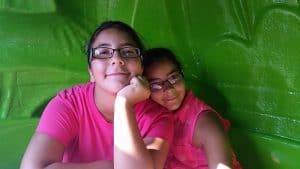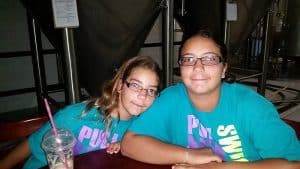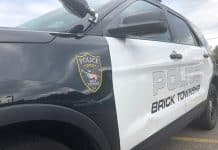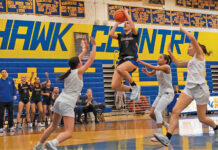
OCEAN COUNTY – It’s something no one wants to think about. And maybe that’s why we need to.
September is Childhood Cancer Month, which is symbolized by gold ribbons. The intent isn’t just to make people aware of it, but to promote funding for research and nonprofits that help families in need.

Two years ago, Tim and Janet O’Brien lost their daughter, Emiliana, to osteosarcoma, a cancer that starts in the bones. They started Emiliana’s Hope, and work with the Pediatric Cancer Foundation.
“Everyone shies away from it, family and friends included,” Janet said. “People want to put their head in the sand.”
It can even be the last thing that a doctor thinks about, too.
Her doctor had thought the pain in her shoulder was a pulled muscle, Janet said. They did an X-ray, but not an MRI, thinking it was tendonitis. Months later, an MRI was finally performed and the cancer was found. By that time it was 11 cm, and had hit her lymph node and lung.
“She had a misdiagnosis for six months and it basically spread throughout her body,” Tim said.
“Two years later, the family is still suffering,” Janet said. Caitlyn is 12, and Connor is almost 2.

“We were a family of 5 for only 7 short weeks,” Janet said at a golf outing fundraiser. “Connor will never remember his sister holding him, singing to him, playing with him. Caitlyn lost her confidant and best friend. They did everything together. It’s not fair that Caitlyn and Connor lost their sister because there isn’t enough funding for childhood cancer research.”
Their organization has helped six other families with their financial needs, sponsored scholarships, and helped out in ways to fill in the blanks of service for families dealing with childhood cancer. Research and funding for childhood cancer is disproportionately small compared to adult cancers.
Between birth and 19 years, there are approximately 15,800 cancer diagnoses a year nationwide, said Michael B. Harris, a pediatric hematologist-oncologist with Hackensack Meridian Health, quoting the Center for Disease Control. This equates to about 43 a day, enough to fill two classrooms. This number has been going up in recent years. Part of this is that detection is better, but that doesn’t account for all of the increase.
“It’s such a steady increase. It could be the detection is better, but it could be incidences are going up for other reasons we don’t know,” Harris said.

Of them, acute lymphoblastic leukemia is the most common, affecting 20 percent. This is followed by 18 percent brain and central nervous system cancers, and 15 percent lymphomas. Osteosarcoma and Ewing sarcoma make up about 5 percent.
“It’s actually a national tragedy,” he said, speaking of how the impact is felt in a family for generations. “Every time you lose a child you lose a universe.”
The most positive statistic is that 82 percent of children diagnosed with cancer survive it.
“Our goal is to cure 100 percent of children,” he said. That’s why it’s important to raise money for research and support.
Even if a child is cured, their struggle doesn’t end there. Part of spreading awareness is telling patients that they are in this for life. There will be other issues they have to look for as they get older. For example, if someone is irradiated for lung cancer, there is a greater likelihood that they will get breast cancer down the road. As a result of researching these connections, doctors are now using less radiation in treating lung cancer.
Therefore, monitoring the patient is really important. They have to take better care of themselves. The research has told doctors what to look for, and the patients need to keep it in mind.

Approximately 60 percent of survivors have some kind of problem afterward, but that number is starting to go down, Harris said.
“We’ve taken an acute disease and it’s become a chronic disease,” he said.
There’s a psychological problem, though. After years of cancer treatments, patients and their families are tapped out. They don’t want to see another hospital again for the rest of their lives. They take the all-clear from the doctor as a victory and try to move on.
Only about half of them do the follow-up that they are supposed to do, he said. Some patients will come in and vomit because they have begun to associate hospitals with the nausea-inducing chemotherapy. It becomes psychosomatic.
This is why Hackensack Meridian started the survivorship treatment program in a separate location.
“They don’t have to sit in a clinic that brings back so many memories,” he said.
Insurance companies also don’t see the value in survivorship treatment. Once the expensive cancer treatments are done, the insurance companies don’t want to pay for any follow-up. That’s why a lot of it is supported through philanthropy, Harris said. Organizations like the Sohn Research Foundation and Tomorrows Children’s Fund have been instrumental. “Without their help, we would probably have to close the program.”
What Makes A Cancer Cluster?
 The same year that Emiliana O’Brien was diagnosed, so was Trevor Kwatkoski. His family started Team Trevor, also raising funds and awareness. Both kids were from Bayville and both were diagnosed with osteosarcoma.
The same year that Emiliana O’Brien was diagnosed, so was Trevor Kwatkoski. His family started Team Trevor, also raising funds and awareness. Both kids were from Bayville and both were diagnosed with osteosarcoma.
That kind of coincidence worried local residents.
“Osteosarcoma is diagnosed in 400 kids a year and we have two of them right here,” Tim said.
Tim said he had done some research into the environmental issues in the area. There was some minerals in the water in the 1920s, but no other red flags.
In Dan Fagin’s book, “Toms River,” he traces the history of epidemiology, the study of how disease is contracted, as background for the cancer cluster story in Toms River. At the end, the epidemiologists were unable to prove that drinking water was contaminated by Ciba-Geigy or Reich Farm, but suggested that there was a correlation. Part of the problem was that epidemiology is a growing field; new technology can prove something today that couldn’t be proven decades ago. Another part of this is that every cancer is a different disease, with potentially different causes, and it might not be appropriate to lump them together.
“Environmentally, it’s very difficult to figure out,” Harris said.
It’s also not caused by one exposure. You don’t drink contaminated water once and then get cancer. The current thought on the subject is that it takes a prolonged exposure that is not likely in very young children.
Certain cancers are tied to workplaces. For example, prolonged exposure to asbestos is a known causality.
“Cancer is common,” Harris said. The Toms River case is a very famous one. Erin Brockovich’s case against an energy company contaminating groundwater is another. So, cancer clusters are on everyone’s mind, even if a cluster is difficult to define.
For more on Emiliana’s Hope, visit the website www.emilianashope.com.






